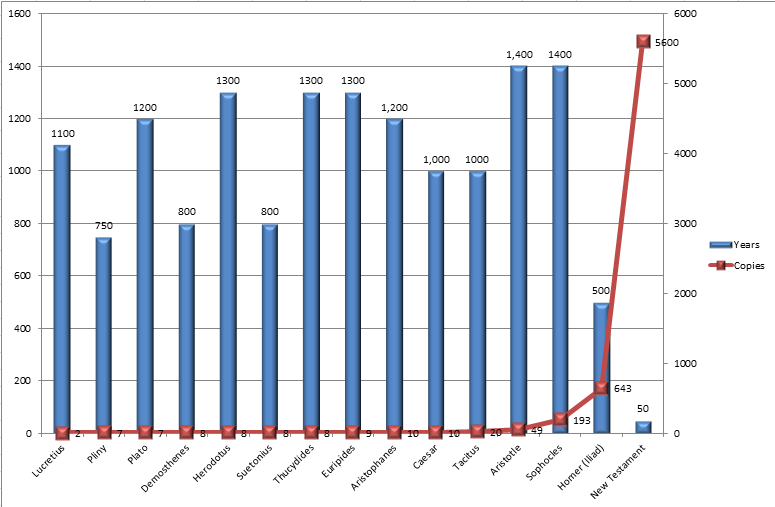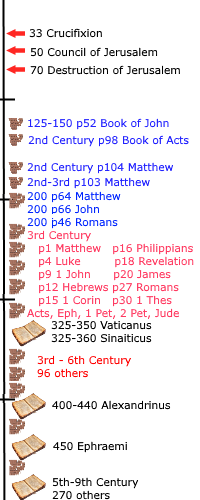Earliest Manuscripts Lead Right to the Door of the Church Fathers
What Every Muslim Needs to Know About How We Got the New Testament (Injeel), part 3
| An author takes a series of steps to write a book. He might plan an outline, a storyboard, or develop a rough draft. Next, he might have someone proof-read or edit his work. Finally, he would publish his work. The tools used in each of these steps may advance and change over time and the steps may involve one person and be informal or an entire company with a thoroughly documented process. The Christian doctrine of the inspiration of Scripture does not supersede this process.
The New Testament did not drop out of heaven. It was authored and published in the same manner as any other book. 2 Pet 1:21 describes how men were carried along by the Holy Spirit like a boat is carried along by the wind. They were not replaced by God but he managed the process. There is no angel whispering in a cave to one person in the Christian view of inspiration. We have multiple attestations with historical veracity of the public deeds and words of Jesus, his apostles, and their followers. We have overwhelming evidence that the 4 gospels, Acts, and 13 epistles of Paul were immediately received, copied and disseminated. This includes Greek copies as well as near immediate translations into other languages.
In the 1st century, papyri were used for writing letters. It was made from papyrus reeds whose stems were sliced and then pressed together. At first, they were kept in scrolls but the time of the New Testament was a time of transition when papyri was being placed in sheets and bound together in a codex (the origin of the book). Tradition has it that Mark wrote his gospel as told by Peter. Perhaps he wrote rough drafts on papyrus but this would have been expensive. Sometimes, an author would pour wax on a table and write his rough draft in wax where he could re-melt sections that he would want to refine before committing to papyrus.
Later we have scriptoriums where manuscripts are copied and these typically would be located in a monastery. One method involved a reader reading slow enough for a scribe to write his words. Another method would involve one person reading one line at a time and writing on a prepared parchment. Sometimes Scribes would put a little number in the corner that served as a quality assurance check signifying the number of words on a page and matching with another copy. Just over 100 copies and fragments of the books of the NT on papyrus remain. A few from the 2nd century and over a dozen in the 3rd century. About 96 others are from the 3rd to the 6th century.
We also have over 5500 lectionaries. Lectionaries are very important. They are not copies of the text but are arrangements of the text used in public worship and for liturgical reasons. We have extremely early evidence that this practice began from day one. Some of the early papyri fragments that we have may actually be lectionaries that would be kept by the reader of an early Christian community. They have breathing marks and diaresis that tells us that these were used by a public reader. We learn form this that the books of the Bible were seen as canonical and were used in public worship. The role of the reader was very important in the early life of the church. In times of persecution, the reader was sought out by government officials because they sought to eradicate the books of the church and the reader kept them. This is how we know which books were received.
How reliable is the New Testament, historically speaking? How does it compare to other ancient documents? The graph below shows just how reliable and preserved it is. If you read a Roman historian, Plato, Homer’s Iliad with any level of confidence that it is preserved then you are well within your reasonable rights to be overwhelmingly more confident in the NT. For example, the best attested ancient work next to the NT is the Iliad. We have 643 copies or fragments and the earliest is 500 years from the author. The NT has over 5600 fragments with the earliest dating within only decades of the author. It is un-rivaled in its preservation. |
 |
| What about variants? Variants are differences in the copies that we have. Variants can result from copyist error or even a theological agenda of the copyist. The fragments do have variants. So, how similar are all the copies? You may heard it sensationally reported that there are hundreds of thousands of errors. This is a misleading statement and the instances of transmission errors are simply a result of the overwhelming amount of textual evidence available to us.
|
 |
The differences are grouped into text-types. Copies that are similar to each other are considered to come from the same source. The 2 major text types are called Byzantine and Alexandrian and they exhibit over a 90% agreement with each other. So, when we talk about variants, we are only talking about the remaining 10% of the text because the 90% is completely stable. The reason that the number of variants is misleading is that it includes one-off misspellings and word order arrangement (which does not affect meaning in Greek). In 5600 copies, there are over 200,000 such one-offs. Over 90% of the text is in agreement so if you take the percentage of errors in the remaining 10% then you get less than 30,000 variants among 5600 copies. That is under 10 per published text. That is a very low error rate rivaling even modern publishing accuracy.
The Church immediately received the words of the apostles, copied, and disseminated them because they understood that Covenants were written. The gospels were a new covenant and the epistles were their terms. The NT fragments of papyri that we have increases our confidence from the 4th century right to the beginning of the 2nd. Less than 50 years and we have the gospels and the epistles of Paul including very early lectionaries that show us how the NT was received.
50 years is within the lifetime of the first followers of the apostles – the Church Fathers. Can we get closer to the author and can we see how the Church fathers received the texts? Yes, we can see that exactly 4 gospels and 13 epistles of Paul were received immediately, and assembled into a sub-corpus that later was recognized as the bulk of the NT Canon of Scripture.
· How we got our New Testament: Text, Transmission, Translation, Stanley E Porter
|
back to part 2 |
next to part 4 |